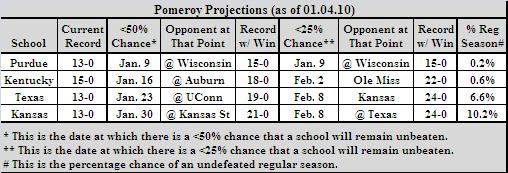Four Teams Chasing Perfection…
Posted by rtmsf on January 4th, 2010Over the long holiday weekend, Syracuse and West Virginia fell from the ranks of the unbeaten, leaving only four teams — Kansas, Texas, Kentucky & Purdue — with a shot at the holy grail of a perfect season. None of the coaches will admit to it on the record, but they all hate losing, and each of them would welcome a chance to become the first team since Indiana in 1976 to win every game put in front of them. There’s only one problem. It’s collectively called the Big 12, SEC and Big Ten gauntlets schedules.

As you’re well aware, there have only been two schools in the last two decades who have run the regular season table — UNLV in 1991, and St. Joseph’s in 2004 — and of course the aforementioned Hoosiers a generation ago were the last to go unblemished throughout. There are many reasons for this, especially given that it’s difficult to win every single game with a growing target on your back, but the primary reason that Tark’s Rebels and Martelli’s Hawks were able to do it when so many other great teams were not was because they played in mid-major conferences (the Big West and Atlantic 10, respectively). This is not to say that those conferences are cakewalks, because they’re not. Every league has its share of rivalry games, other good programs and rattlesnake pits disguised as home gyms that make life difficult on favorites. But what those conferences provide that is often missing among the BCS conferences are the true bottom-feeders that give elite teams such as UNLV/St. Joe’s breaks on a given night. Have a tough shooting night at Vandy or Baylor? You’re going home with your first L. A tough shooting night at Fordham or Long Beach, though? You’re probably still ok.
With the clear knowledge in mind that all four of the remaining unbeatens are going to lose a regular season game (or several), let’s take a look at the remaining schedules to pinpoint exactly when and where that might happen. First, let’s see what Pomeroy has to say. He provides percentage odds on every future game, and if you extrapolate out over the rest of the year, you can start to pinpoint the true likelihood of when that first loss might occur.

This is a good starting point, as Purdue appears to be the most likely candidate to lose next (@ Wisconsin on Saturday), while Kansas seems to be the most likely team to run the table (10.2% isn’t exactly a lock, though). The statistical analysis Pomeroy provides only tells part of the story, though, so we’re going to break down each team’s likelihood of its next loss using another analytical tool – our brain.









































